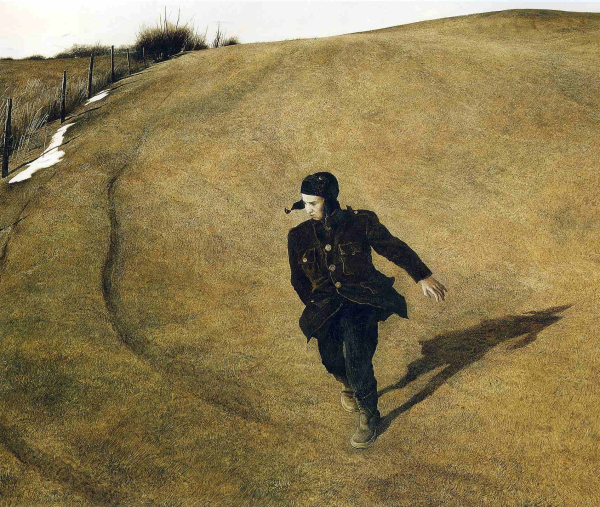WINTER 1946 by ANDREW WYETH
 BY CHRISTOPHER MALENEY If you ever take a day trip out of the city and drive for about an hour down Baltimore Pike, past the small towns and strip malls, to Chadds Ford, be sure not to miss The Brandywine River Museum Of Art, a small art museum on the banks of the Brandywine River that holds one of the finest collections of American realist art. This summer, being the hundredth anniversary of Andrew Wyeth’s birth, the museum is holding a retrospective of the artist’s life and works called Andrew Wyeth: In Retrospect. Son of the world-renowned painter and illustrator, N.C. Wyeth, it was Andrew who established the dynastic status of the Wyeth clan, which has dominated the American art scene for much of the last hundred-plus years. The retrospective encapsulates the life’s work of this renowned, controversial, and enigmatic artist. Born in the midst of the World War I and raised in Chadds Ford, Pennsylvania and Cushing, Maine, Andrew Wyeth’s art depicts scenes and people from these communities, while also reflecting symbolically on a world in flux.
BY CHRISTOPHER MALENEY If you ever take a day trip out of the city and drive for about an hour down Baltimore Pike, past the small towns and strip malls, to Chadds Ford, be sure not to miss The Brandywine River Museum Of Art, a small art museum on the banks of the Brandywine River that holds one of the finest collections of American realist art. This summer, being the hundredth anniversary of Andrew Wyeth’s birth, the museum is holding a retrospective of the artist’s life and works called Andrew Wyeth: In Retrospect. Son of the world-renowned painter and illustrator, N.C. Wyeth, it was Andrew who established the dynastic status of the Wyeth clan, which has dominated the American art scene for much of the last hundred-plus years. The retrospective encapsulates the life’s work of this renowned, controversial, and enigmatic artist. Born in the midst of the World War I and raised in Chadds Ford, Pennsylvania and Cushing, Maine, Andrew Wyeth’s art depicts scenes and people from these communities, while also reflecting symbolically on a world in flux.
Wyeth’s realism, like the trompe l’oeil techniques of the previous generation, are remarkable, but to see only realism is a surface-level reading, for every one of his works operates on a deeper level as well, somewhere “behind the mask of truth,” as Wyeth himself put it. Taken all at once, there is a feeling in many pieces of an exquisite sadness, especially those created after his father’s sudden passing in 1945. In the sparsity of color there is an abundance of emotionality — death, loss, and suffering are here, but only if you look for them. It’s quite easy to go from piece to piece and never look below the surface, but you will miss the truths that Wyeth portrays. Throughout his life, Wyeth painted outsiders to the world: farmers and fishermen, hardworking men and women betrayed by the forces of time, like a field weed crushed under a boot heel. He portrays them physically with every blemish and wrinkle, but symbolically like rooms within rooms, where love must be tucked away to hide from an unforgiving world. One man, James Loper, is seen in two paintings, first casually eying a scythe above his head, and then staring out into the April wind — bent, yes, broken, perhaps, but still stretching towards the sun.
In his later period, Wyeth faced criticism for his seemingly hidebound tendencies, and for his sexual, sometimes racist, portrayals of young women he knew. Yet all this is presented unflinchingly, as a truth that cannot be just glossed over. To see a man through his art, we must see all of it, and not shy away from discussing what is exploitative and what is representative. What stands out afterwards, though, is a certain tenderness for the victims of all the cruelties wrought by the powerful on the powerless. These works are not idle pornography or spectacle, but show with painstaking detail the effects of life’s suffering. A dead bird stands for dying soldiers. A weathered boat in a flowering field signals the passing of an age. This is no celebration of destruction, but an attempt to capture, perhaps to ameliorate, the suffering of the world. What is hated is thoughtless cruelty and dehumanization that can only be overcome by perseverance, even in the face of hopelessness, so that, in the end, we may all take hands in that snow-covered field and dance together around the maypole to welcome in a new world. What other purpose can there be?

